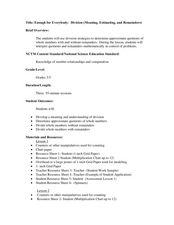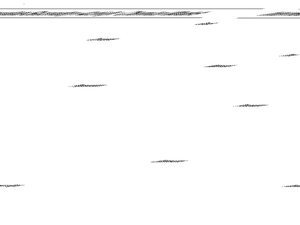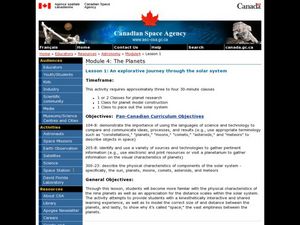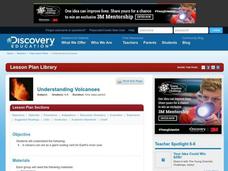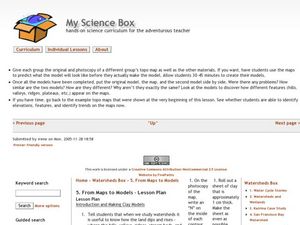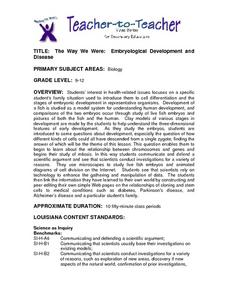Curated OER
Models for Dividing Fractions
Sixth graders represent division of fractions using manipulatives, such as freezer pops, candy bars, and models such as drawings squares. They develop an algorithm from these examples and solve problems using fractions.
Curated OER
Division of Labor
Students study the Industrial Revolution and its effects on workers and productivity in order to explain the concepts of division of labor and cottage industry.
Curated OER
MS Math Dividing Fractions
Seventh graders practice dividing fractions. As a class, 7th graders review multiplication problems and then use a model for dividing whole numbers to discover how to divide fractions. After exploration, the teacher demonstrates the...
Curated OER
Division Problems with 0 and 1
Students explore beginning division. In this division number properties lesson, students solve simple division story problems using cookies. Students create models that represent the identity and zero properties, then write explanations...
Curated OER
Enough for Everybody: Division
Young scholars study division. In this math lesson, students arrange manipulatives into equal groups. Young scholars discuss the relationship between multiplication and division.
Curated OER
Multiplication and Division with Arrays
Students practice the commutative property, create and manipulate arrays and multiply and divide numbers.
Curated OER
Cubic Unit Models
Fourth graders find the volume of solids. In groups, 4th graders use spinners to determine the dimensions of solids. They construct the shapes, creating a model of the figure Students count the cubes in the model to determine the...
Curated OER
Chemical Models
Students study hydrocarbon gases and chemical equations. In this hydrocarbon gases lesson, students work in groups complete a molecular formula worksheet and review alkane prefixes. Students complete molecular models, balance chemical...
Curated OER
Sojourner Model
Sixth graders explore the concept of Sojourner. In this visual arts lesson, student create a model of Sojourner using recyclable or "junk" materials. Students are encouraged to experiment and problem solve to find what works...
Curated OER
Physics and the Quantum Mechanical Model
In this physics worksheet, learners review vocabulary terms and key equations associated with the quantum mechanical model. Students apply the quantum theory to explain the photoelectric effect. This worksheet has 5 true or false, 12...
Curated OER
Edible Model of the Sun
Students identify the different features of the Sun. In this space science lesson, students create a model of its surface using cookies and candies. They compare and contrast their model to the real Sun.
Mascil Project
Closed Greenhouses
Controlling the efficiency of a greenhouse is a mathematical task. A collaborative project challenges learners to create an efficiency plan for a closed greenhouse. Using algebraic equations, they consider a set of constraints, design...
Curated OER
Discover Magazine: Size and Scale
Students research measurements of the moon and Earth as well as the distance between the two in order to create scale models of the Earth-moon system. With a marble to be used as the moon, they must determine how large to make Earth...
Curated OER
An Explorative Journey Through the Solar System
Students explore space science by creating a planetary model in class. In this solar system lesson, students identify the many planets and moons that make up the solar system and decide on one entity in which to research. Students create...
Curated OER
Funtastic Fractions
Learners discover fractions by creating models. In this fractions lesson, students read Give Me Half! by Stuart J. Murphy and view a video about what fractions actually represent. Learners divide a square piece of paper a certain amount...
Curated OER
Understanding Volcanoes
Students create a model volcano in groups, and discuss what each part of the model represents as they go along. In this volcano lesson, students come back together as a whole group and discuss what group did the best work,...
Curated OER
Problems to Solve
In this solving word problems worksheet, students read a word problem with an example of drawing a bar model to solve and use them to solve word problems. Students solve three multi-step problems.
Curated OER
Division with Dividends to 99
In this math worksheet, learners find the answers to the following long division problems. The problems can have remainders.
Curated OER
From Maps to Models
Fourth graders study topography maps and learn the importance of their contour lines. In this map lesson students create their own topography map.
Curated OER
Models and Algorithms to Solve Multiplication Problems
Students choose the correct strategy to solve multiplication and division. In this algorithm lesson, students use at least two strategies that use properties of operations and estimation. Students also recognize the relationship between...
Curated OER
Positive-Negative Charge Model For Integers
Use two different colors of bingo chips to represent positive and negative charges. Add and subtract them in a clear glass beaker to demonstrate how to add and subtract integers. This visual, along with a number line, will really help...
Curated OER
Application and Modeling of Standard Deviation
The first activity in this resource has learners computing the mean and standard deviation of two different data sets and drawing conclusions based on their results. The second activity has them using a dice-rolling simulation to...
Discovery Education
Sonar & Echolocation
A well-designed, comprehensive, and attractive slide show supports direct instruction on how sonar and echolocation work. Contained within the slides are links to interactive websites and instructions for using apps on a mobile device to...
Curated OER
The Way We Were: Embryological Development and Disease
Students use microscopes to study live fish embryos and animated diagrams of cell division on the Internet. They see that scientists rely on technology to enhance the gathering and manipulation of data. They create web pages on cloning.




